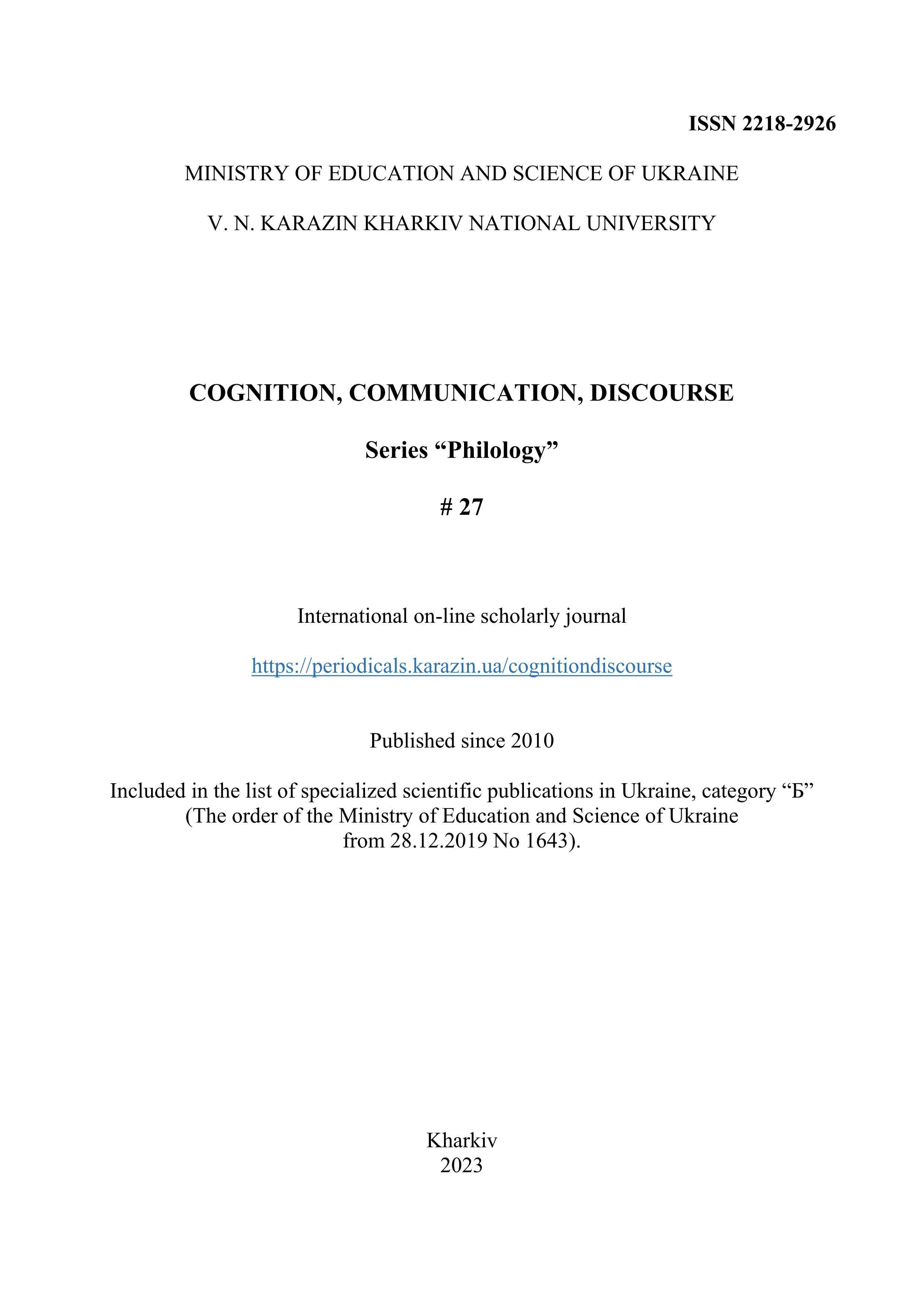Typical agramaticalized constructions as actualized mono- and polysynonymic transforms of virtual primary syntagmata and propositions (on the material of modern french fiction)
Abstract
In this article, mono- and polysynonymic typical agrammaticalized constructions are defined as virtual transforms of primary syntagmata and propositions, actualized in the form of reduced, extended, and quantitatively equacomponential preferential options, in which expressivity prevails over expression. The aim of this research was to suggest a typology and to determine the degree of co(n)textual pertinence of typical agrammaticalized mono- and polysynonymic transforms in modern French fiction. To reach this aim I used the procedure of inverse reconstruction (discourse → language) of the primary structure of the analyzed types of mono- and polysynonymic agrammaticalized discourse innovations. The method of systematization made it possible to build a typology of common agrammaticalized synonymic preferential options. An “alternative” linguistic experiment, i.e., an artificial substitution by the recipient of a certain syntagm or proposition of the analyzed discourse fragment by a synonymic syntagm or proposition, helped to determine the degree of co(n)textual pertinence of the primary structure and secondary synonymic transforms. As a result, the types of mono- and polysynonymic typical agrammaticalized constructions were distinguished, the primary structure and members of virtual synonymic series were inversely reconstructed, and the co(n)textual pertinence of the constructions under analysis was justified by means of the “alternative” linguistic experiment. I claim, that in the French fiction of the 20th ‒ 21st centuries, the most frequent elements are mono- and polysynonymic typical agrammaticalized mono- and polypredicative utterances, extended by the interrogative or relative pronoun que, the personal pronoun il (and its colloquial analogues), quantitatively equacomponential preferential options containing the pronominal component que, and elliptical constructions with final suppression of complement after prepositions avec, sans, pour, contre, parmi, comme. I also claim, that the main reason for actualizing typical agrammaticalized constructions is to emphatically focalize new co(n)textual referents, stylistically nuance the intra- and / or interphrasal co(n)text, syntactically simplify complex structures, or prevent the re-actualization of referents previously introduced to the pre- or post-text.
Downloads
References
Dubois, J. (1963). Grammaire générative et transformationnelle [Generative and transformational grammar]. Langue française, 1, 49-57.
Lepetiukha, A. V. (2017). Rozshyreni synonimichni spoluchnykovi polipredykatyvni struktury ta pidriadni vyslovlennia (na materiali suchasnoi frantsuzkoi khudozhnoi prozy) [Extended synonymic conjunctive polypredicative structures and subordinate clauses (based on the material of modern French fiction)]. Visnyk Zaporizkoho natsionalnoho universytetu: Zbirnyk naukovykh prats. Filolohichni nauky, 2, 101-110.
Marsac, F. (2006). Les constructions infinitives régies par un verbe de perception [Infinitive constructions governed by a verb of perception]. (Thèse pour le doctorat en sciences du langage). Strasbourg, France.
Megentesov, S. A. (1993). Yаzyk kak ob’ekt issledovaniya v svete sinhronno-diahronnoj paradigmy [Language as an object of study in the light of the synchronic-diachronic paradigm]. Filosofiya yazyka: v granicah i vne granic: mezhdunarodnaya seriya monografij, 1, 73-82.
Mellet, S. (1992). Éléments pour une étude de la synonymie syntaxique: l’exemple des conjonctions de cause [Elements for a study of syntactic synonymy: the example of causal conjunctions]. In С. Moussy (Ed.), Les problèmes de la synonymie en latin: colloque du centre Alfred Ernout (Paris, 3 et 4 juin 1992) (pp. 203–222). Paris: Presses Paris Sorbonne.
Styshov, O. A. (2009). Suchasne ukrainske slovotvorennia: osnovni tendentsii rozvytku [Modern Ukrainian word formation: main development trends]. Movoznavchyi visnyk, 8, 135-146.
Tsapiv, A. (2022). Multimodal imagery in picture books for children. Cognition, communication, discourse, 25, 80-88. doi:10.26565/2218-2926-2022-25-06
Valin, R. (1973). Principes de linguistique théorique de Gustave Guillaume. Recueil de textes inédits [Principles of Theoretical Linguistics of Gustave Guillaume. Collection of unpublished texts]. Québec, Les Presses de l’Université Laval. Paris, Librarie C. Klincksieck.
Valin, R. (1981). Perspectives psychomécaniques sur ma syntaxe [Psychomechanical perspectives on my syntax]. Québec: Les presses de l’Université Laval.
Zasiekin, S. V. (2001). Dyskursyvni markery koherentnosti anhlomovnoho dialohichnoho tekstu: kohnityvnyi ta prahmatychnyi aspekty [Discursive markers of coherence of English dialogic text: cognitive and pragmatic aspects]. (Synopsis of unpublished candidate of science dissertation). Kyiv National Linguistic University, Kyiv, Ukraine.
Copyright (c) 2023 Lepetiukha Anastasia

This work is licensed under a Creative Commons Attribution-NonCommercial-NoDerivatives 4.0 International License.
Authors, who publish with this journal, accept the following conditions:
The authors reserve the copyright of their work and transfer to the journal the right of the first publication of this work under the terms of the Creative Commons Attribution License (CC BY), which allows other persons to freely distribute a published work with mandatory reference to the authors of the original work and the first publication of the work in this journal.
Authors have the right to enter into separate additional agreements for the non-exclusive dissemination of the work in the form in which it was published by this journal (for example, to post the work in the electronic institutions' repository or to publish as part of a monograph), provided that the link to the first publication of the work in this journal is given.
The journal policy allows and encourages the authors to place the manuscripts on the Internet (for example, in the institutions' repositories or on personal websites), both before the presentation of this manuscript to the editorial board and during review procedure, as it contributes to the creation of productive scientific discussion and positively affects the efficiency and dynamics of citing the published work (see The Effect of Open Access).




